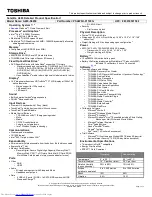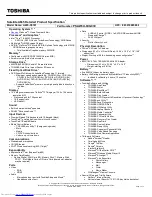
Appendix H - Glossary
162
LED
Light Emitting Diode. A diode that illuminates when
electrically charged. The front panel lights are diodes.
MB
Mega Byte (1 million bytes).
Megahertz (MHz)
A frequency of 1 million cycles per second.
Memory
Devices used to hold information and programs while they
are being accessed by the microprocessor. See also RAM,
ROM, Hard Disk, Floppy Disc, and Removable Storage.
MIDI
Musical Instrument Digital Interface. A hardware specification
and protocol used to communicate note and effect
information between synthesizers, computers, keyboards,
controllers and other electronic music devices.
MMO
Mobile Module, a CPU module made by Intel.
MMX
Multimedia Extensions. A Pentium processor with 57 new
instructions onboard to accelerate multimedia and
communications applications. Running MMX technology
encoded software on a Pentium processor with MMX
technology improves the speed and smoothness of audio and
video playback, image processing and 3D rendering by more
than 60 percent. Current software (not enhanced with MMX
technology) runs 10-20 percent faster on a Pentium
processor with MMX technology.
Mouse
A pointing device to move your cursor within certain software,
such as Windows 95.
Notebook Computer
An extremely lightweight personal computer. Notebook
computers typically weigh less than six pounds and are small
enough to fit easily in a briefcase. Aside from size, the
principal difference between a notebook computer and a
desktop computer is the display screen.ˆ
NTSC
National Television Systems Committee of Electronic
Industries Association (EIA) that prepared the standard of
specifications approved by the Federal Communications
Commission in 1953 for commercial television broadcasting.
Operating System
The software that provides a link between application
programs and the computer hardware (i.e., disks, memory).
The Operating System determines how programs run on the
computer and supervises all input and output. Windows 95/
98, UNIX and Windows NT are examples of popular
Operating Systems.”
PAL
Phase Alternating Line. A European color TV standard that
broadcasts an analog signal at 625 lines of resolution 25
interlaced frames per second.
Partition
A logical unit created on the HDD, which is seen to the OS as
a separate drive. This is necessary on larger HDD on certain
Operating Systems, when restrictions by the BIOS or the OS
limit the maximum amount of memory to which a drive may
be formatted.
PC Card
Personal Computer Memory Card International Association
cards. Credit card sized devices that conform to the
standards of this association. The first cards were memory
cards, but now there is a wide range of PC cards available.
To benefit from PC cards, you must have both the necessary
hardware, and the software. PC card is a popular term for the
PCMCIA specification (16-bit) and is to be distinguished from
the Card Bus specification (32-bit).
Summary of Contents for TransPort NX
Page 10: ...10 ...
Page 18: ...18 ...
Page 42: ...42 ...
Page 52: ...52 ...
Page 60: ...60 ...
Page 128: ...128 ...
Page 134: ...134 ...
Page 150: ...150 ...
Page 152: ...152 ...
Page 156: ...156 ...
Page 170: ...Index 170 Z Zoomed Video 29 ZV 29 Zoomed Video Port 158 ZV Port 164 ZV Port 158 ...









































